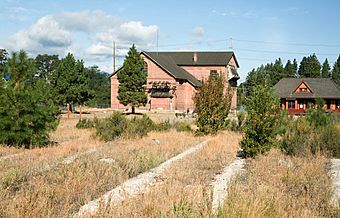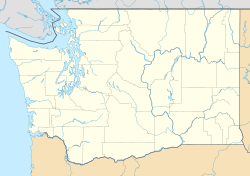South Cle Elum Yard facts for kids
Quick facts for kids |
|
|
Chicago, Milwaukee, St. Paul and Pacific Railroad: South Cle Elum Yard
|
|

View of the railyard. The depot is in the background to the right, the substation is in the background to the left. The ruins of the roundhouse are in the foreground.
|
|
| Location | Near Milwaukee Rd. and Reservoir Canyon Rd. South Cle Elum, Washington |
|---|---|
| Area | 24 acres (97,000 m2) |
| Built | 1909; 1919 |
| Architect | Chicago, Milwaukee, St. Paul and Pacific Railroad |
| Architectural style | Craftsman; 20th Century Vernacular |
| MPS | Milwaukee Road MPS |
| NRHP reference No. | 03000305 |
| Added to NRHP | April 25, 2003 |
The Chicago, Milwaukee, St. Paul and Pacific Railroad South Cle Elum Rail Yard was a very important train hub. It is located in South Cle Elum, Washington. This yard was a key stop for the Chicago, Milwaukee, St. Paul and Pacific Railroad. People often called this railroad "The Milwaukee Road." The yard was built in 1909. It was part of the railroad's big expansion across the country.
Contents
History of the Railroad
Long ago, two major railroads already reached the Pacific Northwest. These were the Northern Pacific Railroad and the Great Northern Railway. To keep up, The Milwaukee Road decided to build its own line. This new line would also go all the way to the Northwest.
Construction on this "Pacific Extension" began in 1906. By 1909, the train tracks reached Tacoma, Washington. This was a huge project for its time.
What is a Division Point?
The Milwaukee Road set up special stops about every 100 to 150 miles (160 to 240 km). These stops were called "division points." At these points, many important things happened. Train engines were fixed and checked. Train crews, like engineers and conductors, would start or end their shifts here. Also, trains were sorted, and train cars were stored.
Division points also had depots or stations. Passengers could get on or off trains there. Goods could also be loaded or unloaded.
The division point at Cle Elum was very important. It was the last stop for crews heading west. This was before trains crossed the Cascade Range mountains at Snoqualmie Pass. After that, they would go into Seattle, Washington. For trains heading east, Cle Elum was the first crew change after leaving Seattle. From there, trains would continue to Othello, Washington and even further to the Midwest and Chicago, Illinois.
The South Cle Elum Rail Yard
The rail yard at South Cle Elum had many buildings and features. It included the main depot building. There was also a roundhouse, which is now just ruins. A turntable was also there, used to turn engines around. It is also in ruins today.
Other parts of the yard included an ash pit and a water tank, which is also now a ruin. The bunkhouse was a place for train crews to rest. They stayed there between their long work shifts. Around 1920, The Milwaukee Road started using electricity for some of its trains. Because of this, an electric substation was built at the yard. Homes for the substation operators were also built nearby.
After the Railroad Left
In 1980, The Milwaukee Road stopped its train service in Washington. The company sold off many of its properties. The old bunkhouse was turned into a bed and breakfast. The homes where the substation operators lived were bought by private people. They still live in those houses today.
The railroad gave its main tracks and other structures to the state. This was instead of paying back taxes. A group called the John Wayne Pioneer Wagons and Riders Association helped a lot. They worked to have the State of Washington Department of Natural Resources (DNR) take over the property. Their goal was to create a walking and biking trail. Because of their efforts, the trail was named the John Wayne Pioneer Trail.
In 1985, the DNR gave the trail to the State Parks and Recreation Commission. This group then created Iron Horse State Park. The remaining buildings, like the depot and substation, became part of the park. The old rail yard ruins were also included. In 2018, the State Park and Recreation Commission changed the trail's name. It is now called the Palouse to Cascades State Park Trail.
Today, the depot building is a museum. The Cascade Rail Foundation runs it for the park. The South Cle Elum Rail Yard and its buildings are very well-preserved. Because of their historical importance, they were added to the National Register of Historic Places in 2003.


